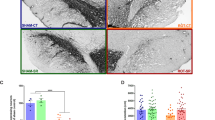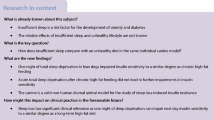Abstract
The purpose of this study was to identify sleep deprivation-induced atrophy and the muscle-specific fiber types affected and to determine the effects of leucine supplementation on atrophy and pertinent portions of the pathways of muscle protein synthesis and degradation in rats. A total of 46 Wistar rats were distributed in four groups: control (CTL), leucine supplementation (LEU), sleep deprivation (SD), and leucine supplementation + sleep deprivation (LEU + SD). Leucine supplementation was by gavage (1.35 g/kg/daily), and the animals were subjected to SD for 96 h. Testosterone and corticosterone concentrations, along with proteins involved in protein synthesis and degradation and proteasome activity levels, were measured in the gastrocnemius (GA) muscle. Myosin ATPase staining was used to evaluate the different muscle fibers. After sleep deprivation, GA muscle and body masses decreased in the SD group compared to the CTL, LEU, and LEU + SD groups. There was no difference between groups in type I fiber cross-sectional area (CSA). The CSAs for type IIa fibers were lower in the SD and LEU + SD groups vs. the CTL and LEU groups, while the IIb fiber CSA was lower in the SD group vs. the CSAs in all other groups. The phospho (p)-Akt levels were lower in the SD and LEU + SD groups vs. the CTL and LEU groups. The p-mTORC1 levels were higher in the LEU, SD, and LEU + SD groups vs. the CTL group. The p-p70S6k levels were higher in the LEU and LEU + SD groups; the 4E-BP1 levels were higher in the SD and LEU + SD groups compared to those in the CTL and LEU groups, and the p-4E-BP1 levels were higher in the LEU and SD groups compared to those in the CTL group and even higher in the LEU + SD group compared to those in the LEU and SD groups. Ubiquitinated proteins, LC3, and p62/SQSTM, and proteasome activity levels were higher in the SD and LEU + SD groups vs. the LEU and CTL groups. Sleep deprivation led to the atrophy of IIa and IIb muscle fibers; however, leucine supplementation prevented muscle loss and type IIb fiber atrophy.



Similar content being viewed by others
Abbreviations
- Akt:
-
Protein kinase B
- ANOVA:
-
Analysis of variance
- CSA:
-
Cross-sectional area
- CTL:
-
Control group
- F Statistic:
-
F value of ANOVA
- GA:
-
Gastrocnemius muscle
- IGF-1:
-
Insulin-like growth factor 1
- LEU:
-
Leucine supplementation group
- LEU + SD:
-
Leucine supplementation + sleep deprivation group
- mTORC1:
-
Mechanistic target of rapamycin-complex 1
- SD:
-
Sleep deprivation group
- UPS:
-
Ubiquitin–proteasome system
- Δ:
-
Variation
References
Baptista IL et al (2010) Leucine attenuates skeletal muscle wasting via inhibition of ubiquitin ligases. Muscle Nerve 41:800–808. doi:10.1002/mus.21578
Baptista IL et al (2013) Correction: leucine and HMB differentially modulate proteasome system in skeletal muscle under different sarcopenic conditions. PLoS One. doi:10.1371/annotation/9060434b-c1df-4d52-8cda-88b9fbfaea51
Breen L, Phillips SM (2011) Skeletal muscle protein metabolism in the elderly: Interventions to counteract the ‘anabolic resistance’ of ageing. Nutr Metab 8:68. doi:10.1186/1743-7075-8-68
Brooke MH, Kaiser KK (1970) Muscle fiber types: how many and what kind? Arch Neurol 23:369–379
Crozier SJ, Kimball SR, Emmert SW, Anthony JC, Jefferson LS (2005) Oral leucine administration stimulates protein synthesis in rat skeletal muscle. J Nutr 135:376–382
Dattilo M et al (2012) Paradoxical sleep deprivation induces muscle atrophy. Muscle Nerve 45:431–433
Dodd KM, Tee AR (2012) Leucine and mTORC1: a complex relationship American Journal of Physiology. Endocrinol Metab 302:E1329–E1342. doi:10.1152/ajpendo.00525.2011
Everson CA, Bergmann BM, Rechtschaffen A (1989) Sleep deprivation in the rat: III. Total sleep deprivation. Sleep 12:13–21
Galvao MO, Sinigaglia-Coimbra R, Kawakami SE, Tufik S, Suchecki D (2009) Paradoxical sleep deprivation activates hypothalamic nuclei that regulate food intake and stress response. Psychoneuroendocrinology 34:1176–1183. doi:10.1016/j.psyneuen.2009.03.003
Geng T, Li P, Yin X, Yan Z (2011) PGC-1alpha promotes nitric oxide antioxidant defenses and inhibits FOXO signaling against cardiac cachexia in mice. Am J Pathol 178:1738–1748. doi:10.1016/j.ajpath.2011.01.005
Klionsky DJ et al (2008) Guidelines for the use and interpretation of assays for monitoring autophagy in higher eukaryotes. Autophagy 4:151–175
Leenders M, van Loon LJ (2011) Leucine as a pharmaconutrient to prevent and treat sarcopenia and type 2 diabetes. Nutr Rev 69:675–689. doi:10.1111/j.1753-4887.2011.00443.x
Machado RB, Hipolide DC, Benedito-Silva AA, Tufik S (2004) Sleep deprivation induced by the modified multiple platform technique: quantification of sleep loss and recovery. Brain Res 1004:45–51. doi:10.1016/j.brainres.2004.01.019
Martins PJ, D’Almeida V, Nobrega JN, Tufik S (2006) A reassessment of the hyperphagia/weight-loss paradox during sleep deprivation. Sleep 29:1233–1238
Martins PJ, Marques MS, Tufik S, D’Almeida V (2010) Orexin activation precedes increased NPY expression, hyperphagia, and metabolic changes in response to sleep deprivation American journal of physiology. Endocrinol Metab 298:E726–E734
Mizushima N, Yoshimori T (2007) How to interpret LC3 immunoblotting. Autophagy 3:542–545
Mônico-Neto M, Antunes HK, Dattilo M, Medeiros A, Souza HS, Lee KS, de Melo CM, Tufik S, de Mello MT (2013) Resistance exercise: a non-pharmacological strategy to minimize or reverse sleep deprivation-induced muscle atrophy. Med Hypotheses 80(6):701–705. doi:10.1016/j.mehy.2013.02.013
Mônico-Neto M et al (2015) Negative energy balance induced by paradoxical sleep deprivation causes multicompartmental changes in adipose tissue and skeletal muscle. Int J Endocrinol 2015:908159. doi:10.1155/2015/908159
Nicastro H et al (2012) Effects of leucine supplementation and resistance exercise on dexamethasone-induced muscle atrophy and insulin resistance in rats. Nutrition 28:465–471. doi:10.1016/j.nut.2011.08.008
Norton LE, Layman DK (2006) Leucine regulates translation initiation of protein synthesis in skeletal muscle after exercise. J Nutr 136:533S–537S
Pereira MG, Baptista IL, Carlassara EO, Moriscot AS, Aoki MS, Miyabara EH (2014) Leucine supplementation improves skeletal muscle regeneration after cryolesion in rats. PloS One 9:e85283. doi:10.1371/journal.pone.0085283
Porkka-Heiskanen T, Zitting KM, Wigren HK (2013) Sleep, its regulation and possible mechanisms of sleep disturbances. Acta Physiol (Oxf) 208:311–328. doi:10.1111/apha.12134
Quy PN, Kuma A, Pierre P, Mizushima N (2013) Proteasome-dependent activation of mammalian target of rapamycin complex 1 (mTORC1) is essential for autophagy suppression and muscle remodeling following denervation. J Biol Chem 288:1125–1134. doi:10.1074/jbc.M112.399949
Sandri M (2013) Protein breakdown in muscle wasting: role of autophagy-lysosome and ubiquitin-proteasome. Int J Biochem Cell Biol. doi:10.1016/j.biocel.2013.04.023
Schiaffino S, Reggiani C (2011) Fiber types in mammalian skeletal muscles. Physiol Rev 91:1447–1531. doi:10.1152/physrev.00031.2010
Schiaffino S, Dyar KA, Ciciliot S, Blaauw B, Sandri M (2013) Mechanisms regulating skeletal muscle growth and atrophy. FEBS J 280:4294–4314. doi:10.1111/febs.12253
Suchecki D, Tufik S (2000) Social stability attenuates the stress in the modified multiple platform method for paradoxical sleep deprivation in the rat. Physiol Behav 68:309–316
Suchecki D, Lobo LL, Hipolide DC, Tufik S (1998) Increased ACTH and corticosterone secretion induced by different methods of paradoxical sleep deprivation. J Sleep Res 7:276–281
van Loon LJ (2012) Leucine as a pharmaconutrient in health and disease. Curr Opin Clin Nutr Metab Care 15:71–77. doi:10.1097/MCO.0b013e32834d617a
van Norren K et al (2009) Dietary supplementation with a specific combination of high protein, leucine, and fish oil improves muscle function and daily activity in tumour-bearing cachectic mice. Br J Cancer 100:713–722. doi:10.1038/sj.bjc.6604905
Wang Y, Pessin JE (2013) Mechanisms for fiber-type specificity of skeletal muscle atrophy. Curr Opin Clin Nutr Metab Care 16:243–250. doi:10.1097/MCO.0b013e328360272d
Zanchi NE (2011) Efeito da Suplementação com Leucina Sobre a Resposta Atrófica da Musculatura Esquelética Induzida pelo Uso de Dexametasona. Universidade de São Paulo, US
Zoncu R, Bar-Peled L, Efeyan A, Wang S, Sancak Y, Sabatini DM (2011) mTORC1 senses lysosomal amino acids through an inside-out mechanism that requires the vacuolar H(+)-ATPase. Science 334:678–683. doi:10.1126/science.1207056
Acknowledgments
Pamella Ramona, Wilson Max, Everald Vancooler, Associação Fundo de Incentivo à Pesquisa (AFIP), Centro de Estudos em Psicobiologia e Exercício (CEPE), Conselho Nacional de Desenvolvimento Científico e Tecnológico (CNPq), Fundação de Amparo à Pesquisa do Estado de São Paulo (FAPESP2012/15869-0; 2013/00152-5).
Author information
Authors and Affiliations
Corresponding author
Ethics declarations
Conflict of interest
No conflicts of interest, financial or otherwise, are declared by the author(s).
Additional information
Handling Editor: M. Engelmann.
Rights and permissions
About this article
Cite this article
de Sá Souza, H., Antunes, H.K.M., Dáttilo, M. et al. Leucine supplementation is anti-atrophic during paradoxical sleep deprivation in rats. Amino Acids 48, 949–957 (2016). https://doi.org/10.1007/s00726-015-2142-7
Received:
Accepted:
Published:
Issue Date:
DOI: https://doi.org/10.1007/s00726-015-2142-7




